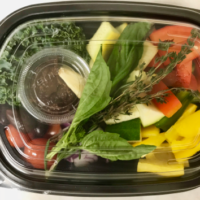When make-at-home meal kits showed up in the marketplace a few years ago, I sort of poo-pooed them. I thought, why would people want to have someone else pick out and then slice or dice their vegetables? Over the past year, I’ve sampled several of the companies that have launched since the original in the industry, Blue Apron, LLC. For the purpose of simply addressing the culinary aspect of the programs, I’ll stick to addressing the food itself, and the ease of preparation for the home cook.
 When I originally assessed these meal programs, I was thinking like a chef, not like a consumer; I’ve had some change of heart on multiple levels. I’ve watched my daughter and son-in-law, and others in various age groups, experiment with assorted meal kits and have drawn some personal and professional opinions. The following are my takeaways after actually cooking alongside my son-in-law to prepare some of these meals.
When I originally assessed these meal programs, I was thinking like a chef, not like a consumer; I’ve had some change of heart on multiple levels. I’ve watched my daughter and son-in-law, and others in various age groups, experiment with assorted meal kits and have drawn some personal and professional opinions. The following are my takeaways after actually cooking alongside my son-in-law to prepare some of these meals.
Advantages of meal kits for the home cooks:
- Home cooks can experience creative and typically healthful meals they might never try on their own.
- Many of the better meal companies use interesting, globally inspired recipes that are not intimidating and simple to execute.
- Using every bit of the ingredients provided is efficient and eliminates waste.
- Portion sizes are ample and satisfying.
- For the most part, ingredients are fresh, local, seasonal, and well-conceived by a team of chefs.
 Now the conversation turns dark and reality sets in. Unfortunately, the larger national meal supply companies, who were the progenitors of this wave, really underperformed for me. Their recipes were not as inspiring as the local companies and the quality of their ingredients was notably not as good. The ingredients were far superior with the local and regional companies, producing in the end, a better-quality meal.
Now the conversation turns dark and reality sets in. Unfortunately, the larger national meal supply companies, who were the progenitors of this wave, really underperformed for me. Their recipes were not as inspiring as the local companies and the quality of their ingredients was notably not as good. The ingredients were far superior with the local and regional companies, producing in the end, a better-quality meal.
My experience with meal kits transcends to my professional work. In the last year, I have designed a number of meal kit programs for retail grocers and universities that take advantage of local resources that can be made in their own kitchens or commissary kitchens. It all makes perfect sense. Seasonally inspired and local ingredients should be featured in proprietary selections of prepared meal choices in any venue.
This recipe for Spicy Chicken Meatballs with Fresh Beet Sauce tested really well and is versatile because you can use any kind of protein you like or keep it vegetarian. In the actual retail supermarket kit, where items like this are offered, a choice of sauces that are made in the commissary or on-site are suggested. You can substitute your own favorite sauce that you keep on hand. These photos show some of the meals created.


Nice piece, Chef. I find the same: local is better, if I do go the kit route. Portion control and low waste are my aims as well.